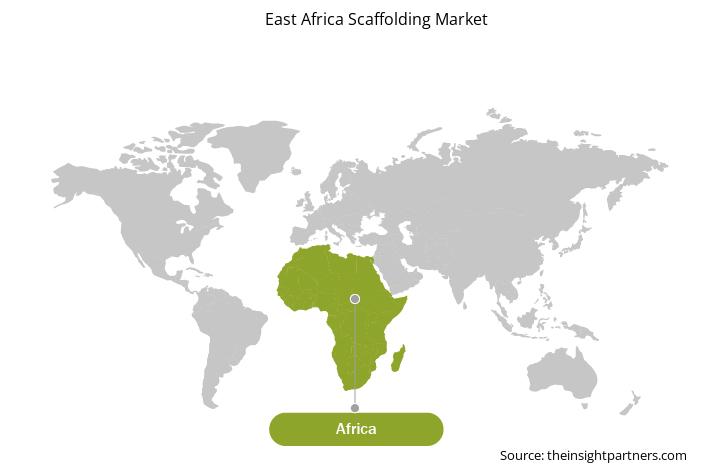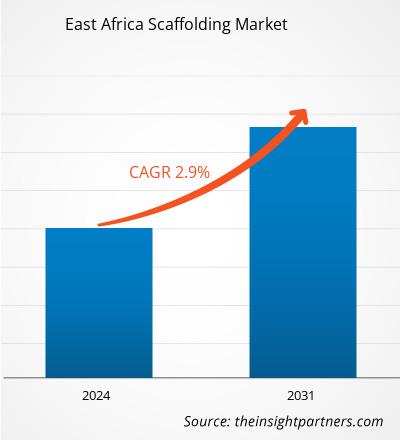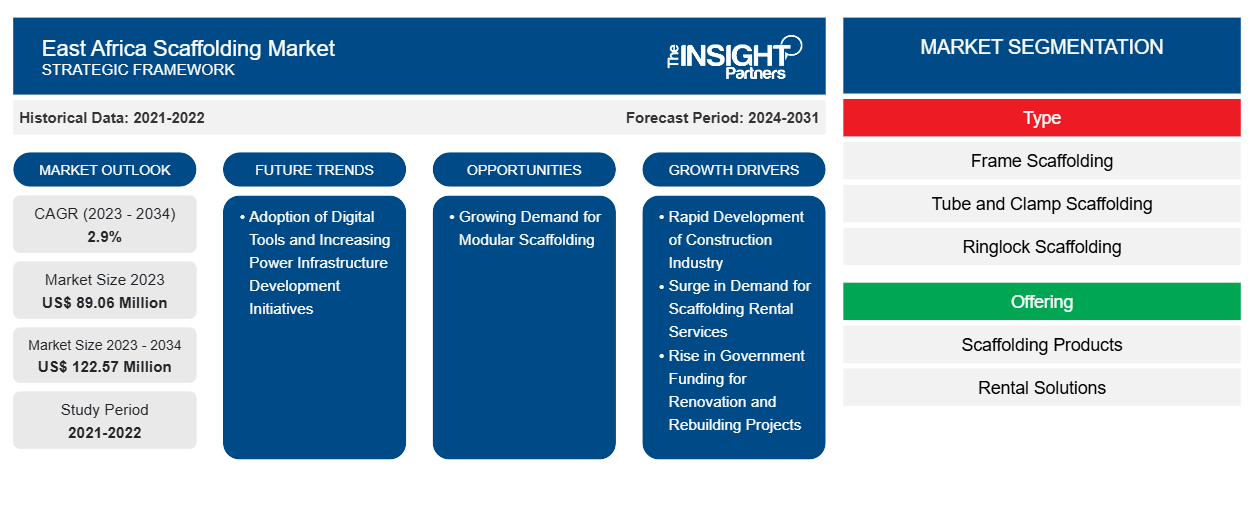足場市場規模は、2023年の8,906万米ドルから2034年には1億2,257万米ドルに達すると予測されています。市場は2023年から2034年の間に2.9%のCAGRを記録すると予想されています。モジュラー足場の需要の高まりにより、今後数年間で市場に新たな主要トレンドがもたらされる可能性があります。
足場市場分析
東アフリカの足場市場を牽引する主な要因としては、建設業界の急速な成長 、足場レンタルサービスの需要の急増、改修・再建プロジェクトに対する政府資金の増加などが挙げられます。しかし、初期投資額の高さと代替手段の存在が、東アフリカの足場市場の成長を妨げています。さらに、デジタルツールの採用とエネルギーインフラ開発プロジェクトの増加により、予測期間中に東アフリカの足場市場で事業を展開する主要企業にチャンスが生まれると予測されています。さらに、モジュラー足場の需要の高まりは、2023年から2034年にかけて東アフリカの足場市場における主要なトレンドになると予想されています。
住宅および商業施設の建設需要の増加と、改修および改造活動への支出の増加は、東アフリカの足場市場の成長にプラスの影響を与えています。歴史的建造物の修復には、元の特徴を維持するために繊細な作業が必要です。足場は、建物の完全性を損なうことなく、修復とメンテナンスを行うための安全で最小限の侵襲性の方法を提供します。東アフリカのさまざまな国の政府は、税制優遇措置の提供、不動産登録の促進、手頃な価格の住宅の優先などのイニシアチブを開始して、積極的に不動産を促進しています。これらの措置は、建設部門への国内および海外の直接投資を促進することを目的としています。
足場市場の概要
東アフリカの足場市場は、タンザニア、ウガンダ、ルワンダ、ケニア、その他の東アフリカに分かれています。東アフリカの足場市場は、住宅、商業、工業、その他のセクターからの足場製品およびレンタルサービスの需要の増加により、予測期間中に2.9%のCAGRを記録すると予想されています。東アフリカの多くの国は、インフラ と住宅地を建設することで国土と経済の発展を目指しています。東アフリカの建設業界は、急速な都市化、インフラ開発、戦略的投資に牽引され、近年成長しています。建設業界は、この地域における足場の主要なエンドユーザーの1つです。足場が関係するこれらの建設プロジェクトには、道路建設、空港のアップグレード、港湾施設の改修、石油およびガスパイプラインのインフラ、上流の製油所建設、再生可能エネルギープロジェクトなどがあります。
要件に合わせてレポートをカスタマイズする
このレポートの一部、国レベルの分析、Excelデータパックなど、あらゆるレポートを無料でカスタマイズできます。また、スタートアップや大学向けのお得なオファーや割引もご利用いただけます。
- このレポートの主要な市場動向を入手してください。この無料サンプルには、市場動向から見積もりや予測に至るまでのデータ分析が含まれます。
足場市場の推進要因と機会
建設業界の急速な発展
住宅および商業施設の需要の増加、政府の取り組みの増加、住宅、商業、産業の高層建築の増加は、建設業界の成長に貢献するいくつかの要因です。いくつかの建設プロジェクトには、住宅、商業施設、インフラ開発、産業施設が含まれます。アフリカ開発銀行のレポートによると、東アフリカは2023年に平均5%の実質GDP成長を達成すると予想されており、アフリカ全体の予測を上回っています。東アフリカの総人口は現在4億8000万人で、2050年までに2倍以上に増加すると予想されています。
国連ハビタットによると、ウガンダは世界で最も高い都市化成長率、つまり約5.7%を記録しています。その結果、政府の手頃な価格の住宅イニシアチブをサポートするアパートやゲートコミュニティへの需要が高まっています。商業、小売、工業部門も、中流階級の増加と消費者支出の増加に牽引されて大幅な成長を遂げています。さまざまな商品や観光部門に対する消費者の需要の増加に対応するため、ショッピングセンター、オフィスビル、ホテル、レストランの建設が増加しています。エチオピア、タンザニア、ケニアは、建設部門の発展に注力している上位の国です。ケニア国立統計局によると、同国の建設生産額は2022年に4.1%増加して172億9,000万米ドルとなり、この部門は国内総生産(GDP)の7.1%を占めました。このように、建設業界の急速な発展が東アフリカの足場市場の成長を牽引しています。
デジタルツールの導入
デジタル化は業界全体で顕著に進んでいますが、特に建設業界では顕著です。この業界では、ビルディング インフォメーション モデリング (BIM) などのデジタル ツールが広く使用されています。BIM を使用すると、ユーザーは建設や足場の仮想 3D モデルを作成できます。建設や足場の 3D モデリングにより、請負業者や建設会社は必要な材料や足場の種類を正確に計画できるため、設計のエラーを減らすことができます。これにより、リソースが効果的かつ効率的に使用され、最終的には運用コストが削減されます。
デジタルツールは、足場プロバイダーが在庫管理、リソース割り当て、プロジェクトスケジュールを最適化するのに役立つデータ分析と洞察を提供します。デジタルツールと自動化を活用することで、足場メーカーとプロバイダーは、業務を合理化し、安全性を高め、プロジェクト全体の効率を改善する高度なソリューションを提供できます。したがって、足場メーカーと建設会社によるデジタルツールの採用の増加は、予測期間中に東アフリカの足場市場の成長で活動する主要企業にとって有利な機会を生み出すと予想されます。
足場市場レポートのセグメンテーション分析
東アフリカの足場市場分析の導出に貢献した主要なセグメントは、タイプ、提供、およびアプリケーションです。
- 提供内容の面では、東アフリカの足場市場は足場製品(販売)とレンタルソリューションに分かれています。レンタルソリューションセグメントは2023年に市場でより大きなシェアを占めました。
- タイプに基づいて、東アフリカの足場市場は、フレーム足場、チューブとクランプ足場、リングロック足場、カップロック足場、およびその他の従来の足場に分類されます。チューブとクランプ足場セグメントは、2023年に市場を支配しました。
- 用途別に見ると、東アフリカの足場市場は、住宅、商業ビル、工業、石油・ガス、イベントに分類されます。2023年には、商業ビル部門が市場で最大のシェアを占めました。
東アフリカの足場市場地域分析
予測期間を通じて東アフリカ足場市場に影響を与える地域的な傾向と要因は、Insight Partners のアナリストによって徹底的に説明されています。このセクションでは、北米、ヨーロッパ、アジア太平洋、中東およびアフリカ、南米および中米にわたる東アフリカ足場市場のセグメントと地理についても説明します。

- 東アフリカの足場市場の地域別データを入手
東アフリカ足場市場レポートの範囲
| レポート属性 | 詳細 |
|---|---|
| 2023年の市場規模 | 8,906万米ドル |
| 2034年までの市場規模 | 1億2,257万米ドル |
| 世界のCAGR(2023年~2034年) | 2.9% |
| 履歴データ | 2021-2022 |
| 予測期間 | 2024-2031 |
| 対象セグメント | タイプ別
|
| 対象地域と国 | 東アフリカ
|
| 市場リーダーと主要企業プロフィール |
|
東アフリカの足場市場のプレーヤー密度:ビジネスダイナミクスへの影響を理解する
東アフリカの足場市場は、消費者の嗜好の変化、技術の進歩、製品の利点に対する認識の高まりなどの要因により、エンドユーザーの需要が高まり、急速に成長しています。需要が高まるにつれて、企業は提供を拡大し、消費者のニーズを満たすために革新し、新たなトレンドを活用し、市場の成長をさらに促進しています。
市場プレーヤー密度とは、特定の市場または業界内で活動している企業または会社の分布を指します。これは、特定の市場スペースに、その市場規模または総市場価値に対してどれだけの競合相手 (市場プレーヤー) が存在するかを示します。
東アフリカの足場市場で事業を展開している主要企業は次のとおりです。
- ヒューゴ スキャフォールズ リミテッド
- ワポ・スキャフォールディング(T)リミテッド
- サウジー・コントラクティング
- リバティ イベント アンド コントラクト スキャフォールディング株式会社
- Form-Scaff (親会社 - WACO International)
- SA スキャフォールドグループ
免責事項:上記の企業は、特定の順序でランク付けされていません。

- 東アフリカの足場市場のトップキープレーヤーの概要を入手
足場市場シェア分析
足場市場レポートの地理的範囲は、詳細な国別分析を提供します。タンザニア、ウガンダ、ケニアは、足場市場で大幅な成長を遂げている主要国です。タンザニアは2023年に22.9%のシェアで足場市場を支配し、予測期間中も足場市場を支配し続ける可能性があります。ケニアは足場市場への2番目に大きな貢献者であり、ウガンダがそれに続きます。住宅、商業、産業建設プロジェクトからの足場需要の増加は、タンザニアでの足場需要を促進しています。タンザニア投資センター(TIC)のプロジェクト登録データによると、2022年7月から2023年6月までの間に、TICは369のプロジェクトを登録し、その価値は54億米ドルに達しました。
運輸、製造、建設、エネルギー、電力など、さまざまな分野でのインフラプロジェクトの開発に対する政府の取り組みと投資の増加は、今後数年間の市場の成長を促進すると予想されています。東アフリカで最も価値のある建設プロジェクトは、タンザニアのリコンゴ・ムチンガLNGプロジェクトです。このプロジェクトは300億米ドルの価値があると予想されており、国内で最も高価なLNGプラントです。建設は2028年までに完了する可能性があります。バガモヨメガポートは、タンザニアの別のプロジェクトで、100億米ドルの価値があり、東中央アフリカで最大の港になると予想されています。
足場市場レポートのカバー範囲と成果物
「足場市場の規模と予測(2021〜2034年)」レポートでは、以下の分野をカバーする市場の詳細な分析を提供しています。
- 範囲に含まれるすべての主要な市場セグメントの国レベルでの足場市場規模と予測
- 足場市場の動向、および推進要因、制約、主要な機会などの市場動向
- 詳細なPESTおよびSWOT分析
- 主要な市場動向、国の枠組み、主要プレーヤー、規制、最近の市場動向を網羅した足場市場分析
- 市場集中、ヒートマップ分析、主要プレーヤー、足場市場の最近の動向を網羅した業界の状況と競争分析
- 詳細な企業プロフィール
- 過去2年間の分析、基準年、CAGRによる予測(7年間)
- PEST分析とSWOT分析
- 市場規模価値/数量 - 世界、地域、国
- 業界と競争環境
- Excel データセット
最新レポート
お客様の声
購入理由
- 情報に基づいた意思決定
- 市場動向の理解
- 競合分析
- 顧客インサイト
- 市場予測
- リスク軽減
- 戦略計画
- 投資の正当性
- 新興市場の特定
- マーケティング戦略の強化
- 業務効率の向上
- 規制動向への対応





















 無料サンプルを入手 - 東アフリカの足場市場
無料サンプルを入手 - 東アフリカの足場市場